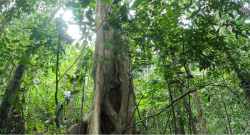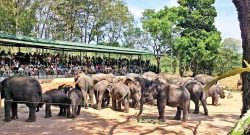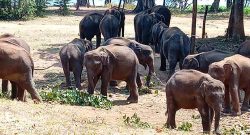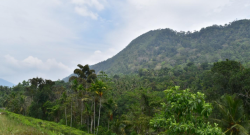Author: Admin
Dilmah’s First Kindness Day – In Memory of Merrill J. Fernando
On May 6th we marked a day of extraordinary significance … the 94th anniversary of Dilmah Founder, Merrill J. Fernando’s birth in the tiny hamlet of Pallansena. With faith in God and a heart of kindness he pursued a passion that touched the lives of hundreds of thousands. On the first Kindness Day, in memory of Merrill J. Fernando, his generations who now pursue the same passion and purpose in tea, cinnamon and hospitality – Malik, Dilhan, Amrit – and the team that strengthens that mission – from Dilmah, Resplendent Ceylon, Kahawatte Plantations, MJF Holdings and other MJF Group businesses, will share kindness from Jaffna to Weligama, Nawalapitiya to Kahawatte, from Pallansena to Batticaloa and many places in between. Kindness is a principle that Merrill J. Fernando formed as the heart of Dilmah, Resplendent Ceylon and each of the businesses he built. It is kindness that strengthens us, and drives us to achieve greater things.
5 ways Endana Nature Corridor in Sri Lanka is a Nature-based Solution
Dilmah Tea, apart from producing some of the best tea in the world, has shown its keenness for environmental conservation, particularly, Nature-based Solutions. In 2018 the Founder of Dilmah Tea, Merrill J. Fernando chose to rewild an area in one of Dilmah’s tea estates located in Endana to create a nature corridor. The Endana Tea Estate, located between two Protected Forest Reserves – Iharakanda and Walangkanda, meant that it could provide a strong link to connect these two patches of protected forest separated by tea lands and human settlements. Found close to Sri Lanka’s only rainforest: Sinharaja, the move to connect the two forest reserves would allow plant life and wildlife to make their way across to the other reserve, leading to higher biodiversity in that area. The Endana Nature Corridor is a 3 Km-long forested pathway that is being established with the help of a team of research scientists led by Professors Nimal and Savithri Gunatilleke, and Dr Nalaka Geekiyanage in the Rathnapura District of Sri Lanka. The corridor is spread across 60 acres taken from the Endana Tea Estate, 2.1 acres taken from active tea plantations and a few more acres of abandoned tea lands in the area. What’s a Nature Corridor? Due to human activity and development, most known National Parks and Forest Reserves in Sri Lanka are scattered and isolated. When animals want to move from one forest to another, they must brave roads, highways, and human populated areas at their own peril. However, a Nature Corridor also known as a biodiversity corridor can act as a bridge of sorts for animals and even plant life (think seed dispersal) to safely cross from one location to the other. What are Nature-based Solutions? Nature-based Solutions use nature’s principles to address contemporary challenges that we face as a society while restoring or safeguarding biodiversity and human well-being. NbSs spring from the knowledge that healthy ecosystems can provide services to humans much more than ailing ecosystems. But what exactly makes Endana Nature Corridor a Nature-based Solution? 1. Inspired by nature The planting method of Endana Nature Corridor mimics the natural succession of the forest floor. This would ensure that over time a forest comes up, is sustainable and can evolve on its own. This method is officially known as the Relay Floristics Method and is a tried and tested method based on science-based forestry principles. It has three phases. First, sun-loving, fast growing, pioneer tree species are planted to restore the bare or degraded land. In the next phase, once pioneer species have sprung-up we can plant native trees that require neither too much sun or shade. By now the forest is taking shape and is ideal for endemic varieties such as Sri Lankan Olive and Breadfruit to be planted. 2. Contribute to Biodiversity The two Forest Reserves, Walangkanda and Iharakanda, are home to many creatures and plant life. When a baseline survey was done in 2018 of the proposed area of the nature corridor 61 tree species and 201 animal species including 34 endemic species were recorded. Among them a total of 53 species of butterflies, 16 species of dragonflies, 12 species of amphibians, 28 species of reptiles, 03 species of fishes, 74 species of birds and 15 species of mammals were recorded. Around 20 of these animal species are threatened. Therefore, the Nature Corridor will conserve and encourage an increase in numbers of tree and animal species on the site by allowing safe passage to migrate from one to the other leading to higher biodiversity. 3. Benefits to People The ENC project adopts an approach that requires community participation for long-term sustainability of the project. The Endana Estate community and residents live close to the forest and use forest resources for their livelihoods and activities such as cooking and obtaining animal fodder. Therefore, it is important to involve them in the project to ensure that forest resources are used sustainably going forward. Following a long-term survey of the villagers and their home gardens, the community was introduced to programmes such as beekeeping, animal husbandry and organic farming. After monitoring their progress, participating community members who have met specific criteria will be rewarded through educational scholarships for their children and monetary awards. 4. Ecological Benefits that can be measured Imagine how much it would cost to generate the oxygen that we breathe for free? Ecosystem services have an economic value. If we do not protect the sources that produce the air, water and food and we let them degrade it would be more costly to restore than it would be to protect them. A calculation made in 2011 estimated that the ecological wealth of this corridor would be around $382,362. 5. Cost Effective Since forests provide certain services to humans, strengthening biodiversity further improves those services. For instance, letting a forest take over this plot of degraded tea estate land would improve the water table levels in this area. Endana Nature Corridor is one of several initiatives under Dilmah Tea’s Green Recovery Programme that aims to improve green cover in several parts of Sri Lanka – a goal in line with the UN Decade of Restoration. Dilmah is invested in environmental conservation through its sustainability arm Dilmah Conservation Learn more about the Endana Nature Corridor here Why Does A Family Tea Business Have a Climate Research Centre? Tea is a product of the elements – the rain, the sunshine, and the soil all play a part in bestowing its inimitable taste. When climatic factors begin to change, it can affect the quality of tea. So it is important to have measures in place to adapt to changes that are beyond our control: like climate change. Further Dilmah is a business that operates with a deep conviction that business must help the people and the planet – Its motto is “Family business serving humanity through kindness to people and nature”. Driven by the need to conserve the environment and those that call it home, the Founder Merrill J. Fernando established a sustainability arm for Dilmah called Dilmah Conservation. As the science of climate change began to evolve, Dilmah Conservation established the Climate Change Research Centre at its One Earth Centre in Nawalapitiya. The goal was to address the lack of scientific research of climate change in Sri Lanka, by facilitating the development of adaptation and mitigation strategies. According to a study by Nature and Climate Change, global agricultural productivity has reduced by 21% since 1961. We are putting in more inputs and getting less yield. And over time the quality of the produce has also reduced. Scientists and researchers have drawn a link between these changes and Climate Change. For businesses in food and agri it is important that they find ways of mitigating and adapting to climate Change. The Climate Change Centre Located in Dilmah’s Queensberry Estate, Nawalapitiya in the hill country of Sri Lanka the Climate Change Centre is surrounded by lush tea gardens, beautiful vistas and high plant and animal biodiversity. The centre facilitates student, national and international researchers at the centre. The Centre is equipped to enable advanced research and thereby comprises two complete sets of DAVIS weather stations, mobile air quality monitor and outdoor air quality monitoring system, with live feed. It is also empowered with stereo and contrast microscopes with a field-level lab area to conduct immediate analysis and identification on-site during the research work. Up-to-date the centre has enabled 30 research among which, are 03 international researches. Up-to-date the centre has enabled 30 research among which, 03 are international researches. Some of the noteworthy climate research projects: 1. Impacts of Pollution in Forests Pollution, more specifically climate change causing Greenhouse gases such as Nitrate and Ammonia, has a harmful impact on forest species sensitive to pollution. Since the Queensberry Estate has an abundance of lichen (a plant like organism made of alga and fungi that is an indicator of a healthy environment), the Dilmah climate change centre was ideal and therefore chosen for a long-term study into the effects of ammonia pollution on Sri Lankan lichen species. So what? South Asia is one of the hotspots of pollution which now reaches even remote forest ecosystems. Research into the impacts of pollution is lacking and therefore is not considered when making policies. This international research spearheaded by the South Asian Nitrogen Hub (SANH) can bridge the gap and help in making headway into controlling GHG emissions for Sri Lanka to contribute effectively to sustainable development and a healthy nation. Research Title: Assessment of Nitrogen Air Pollution Impacts on Forest Ecosystems by the Centre for Ecology & Hydrology, Edinburgh and National History Museum 2020- Present Research Team : Dr. Gothamie Weerakoon, Prof. S. P. Nissanka, Prof. Mark Sutton, Dr. Matthew R Jones, and Prof Dave Reay 2. Climate Change Effects on Tropical Rainforests Sri Lanka is facing increasing temperatures and altered rainfall patterns – considered to be a major aspect of long-term climate change. This research was designed to assess the effects of long-term climate change on tropical rainforests in Sri Lanka. So what? The responses have been favourable for the applications on the selected vegetation. Based on the findings further research is being carried out to identify the indicator lichen species and other ferns. Research to uncover the effects of climate factors on ammonia impacts and the relationship between these components with the agricultural practices is also underway. Research Title: Forest Ecology and Climate Change – Prof. Costa from Peradeniya University and other students from Jaffna and Rajarata University – 2018 – 2020. Research Team: Prof. Janendra De Costa, University of Peradeniya, Miss. Nimaka Sanjeewani, University of Jaffna, and Dr. Sampath Wahala, Sabaragamuwa University 3. Assessing the Biodiversity around the Climate Change Centre The centre sits surrounded by tea gardens in Dilmah’s Queensberry Estate teeming with biodiversity. To conserve the animal biodiversity, the animal population in the area needed to be monitored. Baseline research was conducted around the Climate Research Centre using camera traps using camera traps, line transects, point counts, opportunistic observations, dung beetle traps and previous records. So What? The study documented the diversity of bird, butterfly, dung beetles and mammals in select forest locations adjoining the Queensberry estate. This data can serve as a baseline for future research to assess the impact of climate change on the biodiversity in the area. Research Title: Introducing Novel Technologies for Better Conservation Management of Agricultural Landscape Research Team: Prof. Enoka Kudavidhanage, Ravi Amarasinghe,Asanka Jayasuriya, Bimal Herath, V. A. T. Prabashwara, Amila Perera, Thilina Dilsara. 4. Impact of Climate on Tea Harvest The ultra-sensitivity of tea crop and its yield against climatic factors such as increasing temperatures and soil moisture the low elevations are well proven over the last 100 years, stating that the tea industry in Sri Lanka is clearly vulnerable to predicted climate changes, and greater economic, social and environmental problems. Research title: Impact of weather patterns and the terrain factors on tea productivity – University of Colombo – 2018- present * * * Agriculture cannot evolve in silo without considering the changes in weather patterns, soil, water tables and more. With Climate Change, the agricultural sector must find new ways of adapting and mitigation. To do so evidence in Sri Lankan context is lacking. Studying the impacts of climate change on Sri Lanka’s forests, Sri Lankan soil and Sri Lankan weather can arm the sector with the resources to be more climate resilient.
Count Her In- Women’s Day Program to Empower Female Micro and Small Entrepreneurs
At Dilmah, we believe in supporting women not just for a day, but for as long as we can. That’s why this International Women’s Day we initiated the #CountHerIn program, designed to empower aspiring women entrepreneurs! This was a part of our ‘Empower’ series of initiatives where we do what we can to help people grow from strength to strength. We opened this program to women with dreams of turning their small businesses into a reality. From bakers, builders, designers, dreamers, and doers we received over 140 applications from dynamic female micro and small entrepreneurs who were ready to take their ventures to the next level. Here’s what the program offered: When you empower a woman, you empower a family, a community, a world. Join us to #CountHerIn, #EmpowerHer and #CelebrateHer
Uda Walawe ETH: A home away from home for baby jumbos
As the clock struck 10.15 am, groups of visitors had already taken their positions at the pavilion. Filled with loud chatter and laughter, they were checking their watches in anticipation for the much ‘look forward to’ event to begin at any moment. By about 10.28 am, the ‘players’ were making their way towards the ground. But this time, the players were indeed show-stoppers. They were tiny but playful. Certainly not kids, but childlike. And as the gates opened, the tiny creatures were racing up to get their second quota of milk for the day. We were witnessing another typical feeding hour at the Uda Walawe Elephant Transit Home (ETH). The Uda Walawe ETH was set up to rehabilitate elephants that were orphaned due to various reasons including the Human-Elephant Conflict. At the ETH, elephant calves have very little contact with humans which is vital to boost their chances of survival in the wild. Here, human interaction is only limited to feeding hours. The calves are being fed every three hours with infant milk but also encouraged to develop natural foraging habits including grazing. An occasional trumpeting indicated that some calves were protesting for more milk. The keepers and the staff have dedicated their time and effort to discipline the one or two mischievous calves. “It costs around Rs. 250,000 per day to provide milk for these elephants,” said Dr. Malaka Abeywardena, Officer-in-Charge at the Uda Walawe ETH. “They are being fed around six times a day. But one of the challenges that we face is when we reintroduce them to the wild. There are threats in each national park as they are isolated areas. One of the biggest threats they face is the new environment.Since they have habituated themselves with humans they tend to move towards human settlements. We don’t have a better environment to release them.” The Uda Walawe ETH is currently home to a herd of 58 elephants and each one of them is being well looked after. “We treat calves which are below seven years of age. We cannot treat elephants older than that as we have limited facilities. But even amidst financial and other challenges we hope to do our best to conserve elephants in the country,” Dr. Abeywardena added. In a bid to spread more awareness among visitors to the Uda Walawe ETH, Dilmah Conservation in collaboration with the Department of Wildlife Conservation renovated the ‘Elephant Knowledge Walk’ to educate local and international visitors on why the Asian elephant needs to be protected. Apart from that a souvenir shop was also opened to support local communities. Chairman, Dilmah Ceylon Tea Company PLC Dilhan C. Fernando addressing the gathering at the launch said that elephants are very important. They are ecosystem engineers, keystone species, charismatic and beautiful animals. But today it is more about nature and what we need to understand is that in our value-driven economy, we sometimes marginalize some of the most important things such as land, water and animals. Elephants are part of the ecosystem that keeps us alive. What is important is to understand the reality. While we have built an economy that has an unconscious bias against nature, we also need to realize the value of elephants and a lot of their species. The nearest estimate is that in a lifetime a single elephant can add around USD 1.6 million to the economy. This is in terms of tourism, benefits of restoration of ecosystems and so on. The reason why Dilmah got involved here is that my father established the business and we recognized that with tea we have an enduring connection with nature. In order to ensure that we interact sustainably with nature it is as important as the work we do in selling our tea. Today we’re here to honor that association. There are unborn generations who can’t think. What we do today will decide whether they have sustainable lives or lives of unspeakable hardships with the collapse of ecosystem services. It’s about nature, life, civilization and the future.” Biodiversity conservation as a development priority “We in Sri Lanka always look at development to be the priority of this country,” said senior elephant researcher and former Director General at the Department of Wildlife Conservation Dr. Sumith Pilapitiya. “But this development should be sustainable. If development is not sustainable we have not achieved anything. We have to study what makes development sustainable. This is where Sri Lanka is failing. For development, there’s what is called ecosystem services necessary for development. These include services such as the availability of water, good weather, fertile soil, carbon sequestration and so on. Without these services there cannot be any kind of development because development has its own basic needs. So how do we ensure that we have enough ecosystem services for sustainable development? Studies done worldwide have shown a direct linkage between ecosystem services and development. The more ecosystem services that natural ecosystem services can produce, the greater the potential for development in that country. But the greater the biodiversity in that ecosystem, the greater the ecosystem services; which means greater the possibility for development. Therefore most countries talk about biodiversity conservation as a conservation priority of the country. But it shouldn’t be a conservation goal but a development goal. If you don’t conserve biodiversity you will not have adequate ecosystem services and there will be no space left for development. Therefore the government should make biodiversity conservation a development priority. But if we look at how we are conserving biodiversity I’m very sorry to say that the scorecard doesn’t look very good.”He further said that according to the IUCN Red List, 33% of Sri Lanka’s inland vertebrate species are highly endangered while 2/3rds of our flora are endangered. “One in 12 species are under severe threat of extinction. Experts say that unless Sri Lanka reverses this trend these species will become extinct. This is the 2007 Red List data and we haven’t done anything from 2007 to today to reverse this trend. So we are in a serious position and we in Sri Lanka are proud to say that Sri Lanka has the highest biodiversity per unit area in South Asia which is true and we are also proud to say that it is a hotspot. I think we should be ashamed to say it is a hotspot because if it is a hotspot that means our biodiversity is under severe threat. Therefore it is nothing to crow about. I feel our long-term development is under serious threat unless we start paying attention to these issues. If you look at our ecosystem, one of the critical aspects of the ecosystem is the elephant. The elephant is a flagship species. It’s a keystone species and an elephant is known as an ecosystem engineer because an elephant’s presence in an ecosystem balances that ecosystem’s development. Conserving elephants in Sri Lanka is one of the greatest challenges that we face. Unfortunately, the HEC is threatening the future of elephants in this country and it is a serious problem for humans too. The only way I could see the HEC easing in this country is when people particularly those in areas and sharing landscapes with elephants consider the giants as economic benefits. At this point, an elephant is only an economic liability to people living in areas in the presence of elephants.” Dr. Pilapitiya suggested that one way of making elephants an economic benefit to the people is community-based elephant viewing tourism where communities will be able to start making money from elephants. As the ribbons were cut and the oil lamps were lit on a ceremonial note, we took a tour around the Elephant Knowledge Walk. From the evolution of an elephant to its life cycle, behaviours, breeding patterns, relationships, communication systems, threats and challenges, myths and beliefs, the anatomy of an elephant to the work done at the ETH, visitors can get a broader insight as to why the Asian elephant particularly needs to be protected. The information is presented in a trilingual format for any visitor to understand the importance of protecting elephants without any language barrier. As you walk out you will be greeted by the dominating skeletal frame of Sandagiriya, an elephant that used to live around the Northern boundary of the Uda Walawe National Park. Its skeletal frame stands as a reminder to the aggravating HEC in the area. As it had developed a habit of wandering into the farmlands, the elephant had been shot several times. Even though it had received treatment on numerous occasions Sandagiriya had succumbed to an infection caused by a gunshot wound. Such is the plight of many elephants who wander into human settlements in search of food. If nothing is being done about the ever-aggravating HEC, in time to come, people will be witnessing more skeletal frames of elephants that will be preserved to remind future generations of the treasures Sri Lanka lost. Read the article on the Daily Mirror by Kamanthi Wickramasinghe: https://www.dailymirror.lk/print/news-features/Uda-Walawe-ETH-A-home-away-from-home-for-baby-jumbos/131-279496
HSBC Ceylon Literary & Art Festival partners Dilmah Ceylon Tea to launch Future Writers Program
The HSBC Ceylon Literary & Art Festival in collaboration with Dilmah Ceylon Tea opened its inaugural edition in Kandy announcing the launch of the Future Writers Program. Dedicated to nurturing the creative talents of young individuals, this competition underscores the festival’s commitment to fostering youth development and grooming the creative thinking, enhancing its focus on empowering the next generation. Incorporating platforms such as these serves to underscore the cultural fabric of a society, thereby augmenting the intrinsic value of a nation. Such initiatives foster a sense of purpose among the younger generation, instilling pride and potentially mitigating the phenomenon of brain drain. The platform further establishes an ecosystem that actively engages and fosters creative entrepreneurial endeavours and projects, thereby cultivating a vibrant and dynamic creative culture. Commenting on the launch of the program, Ceylon Literary Festival Founder and Creator Ajai Vir Singh stated: “We are thrilled to introduce our Future Writers Program as an extension of Ceylon Literary Festival. This initiative is not just about discovering talent; it’s about nurturing and fostering a literary legacy that transcends generations. This is the beginning of an investment in the future of creativity, innovation, and cultural enrichment for Sri Lanka. We encourage all students to submit their stories and be part of the program which not only awards the winner but all participants as well.” The youth and next generation being the mirror of the nation require these vital opportunities to equip them to divulge into creative fields beyond the ordinary. The introduction of the Future Writers Program supports and amplifies this with its core effort to cultivate and showcase the creative endeavours of youth. By encouraging participation from individuals aged 15 to 29, the competition aims to provide a platform for emerging writers to explore their literary prowess. Participants are invited to submit short stories on themes such as “Murder at the Festival” or “The Girl at the Workshop,” incorporating the cultural significance of tea into their narratives. Submissions are accepted until 8 April 2024, and will be evaluated by a panel of esteemed judges led by renowned author Ashok Ferrey. Further highlighting the partnership for the program, Dilmah Ceylon Tea Chairman Dilhan C. Fernando stated: “Dilmah is proud to play a crucial role in fostering the development of youth within the creative industry. This is more than just a competition; it’s a celebration of imaginative storytelling, where passion for writing merges with the captivating essence of tea. Being a part of these initiatives can unleash your creative potential, help craft narratives that not only enthral and engage but also highlight one’s talent for weaving ordinary elements into extraordinary tales.” The winning entry will be awarded a cash prize of 100,000 and will have the unique opportunity for mentorship with a celebrated author. Additionally, the winning story will be featured on the Ceylon Literary & Art Festival platforms, offering widespread recognition and exposure. Shortlisted participants will also benefit from attending a Writer’s Workshop conducted by an esteemed author panel. This competition further reinforces the festival’s dedication to fostering creativity and providing opportunities for youth to engage with and contribute to the cultural landscape of Sri Lanka. Applications can be submitted by 8 April 2024 to www.ceylonliteraryfestival.com. The main partners promoting this creative platform to showcase and make it one of the leading platforms is the title partner HSBC along with its other partners Mastercard, The British Council, Galle Face Hotel, Hotel Suisse Kandy, Dilmah Ceylon Tea, Innovate Books, Goethe Institut, Wijeya Newspapers, Emerging Media, Curado, Hardtalk, Sarasavi, Zelus and Acorn. Together, these partnerships embody a shared vision of celebrating and nurturing culture and creativity in Sri Lanka. Read the article on the Daily FT: https://www.ft.lk/entertainment-art/HSBC-Ceylon-Literary-Art-Festival-partners-Dilmah-Ceylon-Tea-to-launch-Future-Writers-Program/10405-760108
Ali Nena Mansala, a significant milestone in promoting conservation awareness
The recently-reopened Udawalawe Information Centre, now known as the Elephant Knowledge Walk at the Elephant Transit Home (ETH) in UdaWalawe, stands as a treasure trove for enthusiasts keen on studying paleontology and all things related to elephants. Since 1995, the Elephant Transit Home in UdaWalawe has been dedicated to rehabilitating and releasing baby elephants back into the wild. Today, it boasts one of the finest collections in the field of elephant science. Dr. Malaka Abeyawardana, the head of the centre, says, “We have successfully rehabilitated over 170 baby elephants, with 58 currently under our care.” This facility has become a much-sought-after tourist destination, attracting over 150,000 local and foreign visitors last year alone, significantly contributing to the country’s income. Acknowledging the importance of raising public awareness about their mission, Dr. Malaka mentions the challenges they face due to a busy schedule and limited resources. Thanks to the assistance of Dilmah Conservation, they’ve established an information centre within their institution. This centre offers valuable insights into elephants, covering their biology, social behaviour, evolution, and the ongoing human-elephant conflict. Additionally, visitors can learn about the rehabilitation centre’s mission. Moreover, efforts have been made to support the local economy by renovating the handicraft shop. In collaboration with the Dilmah Institute, they aim to encourage contributions to conservation efforts while benefiting the local community. Speaking at the grand reopening, Dilmah Ceylon Tea Chairman, Dilhan C Fernando, emphasised the pivotal role elephants play in our ecosystem. He stressed the need to recognise their value, citing estimations that suggest an elephant could contribute up to .6 billion USD to the economy over its lifetime. He underscored Dilmah’s enduring connection with nature and the importance of sustainable interaction with our environment. Elephant researcher U Sameera Weerathunga highlights the urgent situation in Udawalawe National Park, particularly concerning the inadequate food supply for its wildlife. He calls for prompt action, including replenishing grasslands, removing invasive plants, and ensuring the security of surrounding forests. The Elephant Transit Home remains a beacon of hope for young elephants in distress. They receive comprehensive care and veterinary support before being reintroduced into the wild. However, Weerathunga stresses the importance of addressing scientific considerations before releasing them. The centre provides opportunities for community children to develop their latent talentsDilmah Conservation’s invaluable contributions to wildlife conservation in Sri Lanka are recognised and appreciated by the people. Their efforts in research, education, and financial support, especially for the Udawalawe Transit Home, are commendable. Ali Nena Mansala, or the Elephant Knowledge Walk, represents a significant milestone in promoting conservation awareness. Its establishment, in collaboration with the Department of Wildlife Conservation, Dilmah Tea, and Dilmah Conservation Union, is a testament to collective efforts toward conservation. Supun Lahiru Prakash, a conservationist and researcher, sheds light on the dire situation faced not only by Udawalawe National Park but also by elephants across the country. He outlines major challenges, including ecological succession, invasive species invasion, and human-elephant conflict mitigation measures. Despite the severity of these challenges, Prakash emphasises the urgent need for scientific interventions, including habitat management and strict enforcement of conservation laws. Regrettably, the government’s response to the human-elephant conflict has been inadequate. Although a National Action Plan was submitted in 2020, the lack of implementation has been glaring. While presidential task forces are often established for various issues, the absence of one dedicated to managing the human-elephant conflict is perplexing. Instead, a Presidential Committee, lacking necessary powers and funds, has been appointed, further exacerbating the situation. In conclusion, urgent action is required to address the complex challenges facing elephant conservation in Sri Lanka. Failure to do so not only threatens the survival of this iconic species but also undermines the country’s ecological balance and tourism sector. Read the article on The Island by Ifham Nizam: https://island.lk/ali-nena-mansala-a-significant-milestone-in-promoting-conservation-awareness/
Dilmah’s MJF Foundation and University of Colombo Faculty of Medicine unveil Early Intervention Clinic
Dilmah’s MJF Foundation and University of Colombo Faculty of Medicine unveil Early Intervention Clinic March 20, 2024DailyFT MJF Foundation, in collaboration with the Faculty of Medicine, University of Colombo inaugurated the opening of the Early Intervention Clinic, a ground-breaking facility dedicated to enhancing the lives of young children with Down Syndrome, Cerebral Palsy and other developmental disorders on 28 February. The signing of the Memorandum of Understanding took place at the Faculty of Medicine Tower where MJF Foundation Chairman/CEO and Trustee Dilhan C. Fernando joined hands with University of Colombo Vice Chancellor Professor H. D. Karunaratne to formalize the partnership. The Early Intervention Clinic represents a significant milestone in advancing the support available for families and caregivers of babies and toddlers with disabilities. The Clinic offers a multi sensorial support system where social integration meets specialized therapy and paediatric care. Manned by a multi-disciplinary team comprising of physio, occupational, speech and language therapists and medical practitioners, it is tailored to meet the unique needs of each child and support parents and caregivers. Located at the Faculty of Medicine, the Clinic is in the vicinity of paediatric and maternity hospitals, further enhancing its accessibility for new-borns and children from diverse backgrounds and demographics who require specialized care. Early intervention is widely recognized as pivotal in enabling children with disabilities to achieve their full potential. Intervention soon after detection has shown to significantly improve outcomes for children at risk of developmental disorders, highlighting the critical importance of timely diagnosis and treatment. “In most cases, children with disabilities will very rarely get a proper diagnosis” explained Vidya Jyothi University of Colombo Faculty of Medicine Dean Prof. Vajira H. W. Dissanayake. This collaboration also offers more visibility and awareness for such initiatives. With a reach in over 100 countries, Dilmah’s support of projects such as this have the potential to inspire global interest in Sri Lanka’s efforts in healthcare, added Prof. Dissanayake. This collaboration is one of many initiatives between Dilmah’s MJF Foundation and the Medical Faculty. The Foundation’s Centres while catering towards education and therapy for children with disabilities also serves as a centre for practical observations and clinical studies for undergraduates at the University. Dilmah’s unwavering commitment to serving individuals with disabilities is exemplified through a myriad of initiatives, including the management of the Centre for Children with Cerebral Palsy and Other Developmental Disorders (CCCPDD) and the launch of disABILITY, Sri Lanka’s only trilingual channel on disability. Their centres in the East and West also conduct programs and offer facilities for special education and various forms of therapy for children and youth with disabilities. Commenting on the launch of the Early Intervention Clinic, Dilhan C. Fernando remarked, “At Dilmah, we believe that business is a matter of human service. The establishment of this Clinic underscores our commitment to serving humanity and creating a more inclusive society.” The Early Intervention Clinic is now open at the Faculty of Medicine. For further details contact: Faculty of Medicine Senior Lecturer in Anatomy and Family Physician, Department of Anatomy, Genetics and Biomedical Informatics Dr. Dineshika Hettiarachchi, at dineshani@anat.cmb.ac.lk Read the article on the Daily FT: https://www.ft.lk/healthcare/Dilmah-s-MJF-Foundation-and-University-of-Colombo-Faculty-of-Medicine-unveil-Early-Intervention-Clinic/45-759697
Building A Nature Corridor
The Endana Nature Corridor is a long-term forest restoration project implemented in Ratnapura District of Sri Lanka to build a forested pathway spanning across 3 km degraded tea lands and community-owned home gardens. A fragmented forest patch named Iharakanda Proposed Forest Reserve is successfully connected to Walankanda Forest Reserve, which is a part of Sinharaja Forest Range. The corridor spreads across 40 ha of once luxurious British era tea plantations, which are now abandoned for forest restoration. This will succeed in allowing the free migration of wildlife and plant life through effective seed dispersal between the two reserves leading to improved biodiversity. The fact that the project site lies close to Sri Lanka’s largest rainforest: Sinharaja Forest Complex in Ratnapura gives it greater ecological importance. Origins The brainchild behind the idea was Dilmah Tea’s founder Mr. Merrill J Fernando, who was an advocate of green restoration among many other things. The project initiated in January 2018 by symbolically uprooting exiting tea bush, which is now advised by Professors Nimal Gunatilleke and Savithri Gunatilleke of University of Peradeniya and led by Dr Nalaka Geekiyanage of Rajarata University of Sri Lanka. The significance of the work done on the corridor during its formative years garnered a prestigious grant from the Franklinia Foundation, Switzerland with ample co-financing for a period of four years. Figure 1. A partial landscape view of the project site including Iharakanda Proposed Forest Reserve and community-owned home gardens Figure 2. A map of Endane Nature Corridor, Iharakanda Proposed Forest Reserve and Walankanada Forest Reserve in Southwestern Sri Lanka An Ecological Restoration Method The planting method of the Endana Nature Corridor mimics the natural succession of lowland rainforest. This would ensure that over time a forest comes up, is sustainable and can evolve on its own. This method is known as the Relay Floristics Method and is a tried and tested method based on the principles of ecological restoration. First, sun-loving, fast growing, pioneer tree species are planted to restore the bare or degraded land. In places where pioneer vegetation comes up naturally among the abandoned the bushes are left intact for natural regeneration. In the next lap, once pioneer species have sprung-up we can plant native trees that require neither too much sun nor shade. By now the forest is taking shape and with a few thousands of seedlings of threatened tree species are now inter-planted. Figure 3 An established plant nursery with endemic and native plants including threatned species Introducing threatened Species to ENC The Endana Nature corridor has progressed to introduce 47 globally threatened tree species through multiple tree planting campaigns. All planted seedlings are geotagged using GNSS technology and monitored through an Android mobile application where further details such as initial growth and functional traits data, as well as canopy openness and other microclimatic data around planted seedlings are recorded. Figure 4 Monitoring the growth of planted saplings Exploring Hidden Biodiversity Extensive surveys have been conducted from time to time to explore the plant life in the Walankanda Forest Reserve adjacent to the project site. Mother populations of 544 plant species were georeferenced Of them, 212 (~40%) are endemic to Sri Lanka, and among them 204 are recorded in the Endane Nature Corridor. Figure 5. A view from Walankanda Forest Reserve Uplifting the Local Community Community participation is needed for long-term sustainability of any forest restoration work. The Endana Estate community and residents living close to the forest and those who use forest resources for their livelihood activities such as cooking and obtaining animal fodder are actively involved in the forest. Therefore, the project has identified that it is important to involve them in the project to ensure that forest resources are used sustainably and in an equitable manner. Figure 6 Community member is awarded for their sustainable actions as responsible stewards showcasing a model payment for ecosystem services They are assisted with technical expertise and resources to begin sustainable community beekeeping, animal husbandry and organic farming. Figure 7. Community member at one of the planting campaigns Figure 8 Community members with Beekeeping expert Dr Anura Indrajith, Mr. Amila Perera and Dr. Nalaka Geekiyanage Educating and Spreading Awareness Believing in SDG 17: partnership for goals and strengthening participation and rallying support in all fronts, awareness sessions about forest restoration activities are held at intervals for Forest Officers, Dilmah Conservation staff, and local administrators. General population of local community are engaged through hands-on trainings in the hopes that they too will take on the responsibility of safeguarding the natural Figure 9. An awareness programme for pre-school kids in Endana community Creating Rippling Impact Shorea ovalifolia – a species thought to be extinct in the wild was rediscovered and its seedlings nurtured for field planting. The 2020 red list issued last year listed this species as Critically Endangered (CR). A few new species to the flora of Sri Lanka are earmarked, which are monitored for further verification and writing scientific manuscripts. A new leafless species of orchid, Gastrodia pushparaga, was discovered during one of the project’s mandated research work in 2021 by a team that included Dilmah Conservation Centre Coordinator, Amila Perera, along with other research team members including Bathiya Gopallawa, Indrakeela Madola, Deepthi Yakandawala, Pankaj Kumar, Harsha Jayawickrama, and Mark Chase. The species is known to be threatened due to the small population size which could be classified as threatened as per IUCN guidelines. Figure 10. Newly described leafless orchid in Sri Lanka named after a precious yellow sapphire Did you know Dilmah donates 15% of its pre-tax profits for humanitarian and environmental conservation initiatives driven by its own humanitarian arm the Merrill J Fernando Charitable Foundation and environmental conservation and sustainability arm, Dilmah Conservation?








